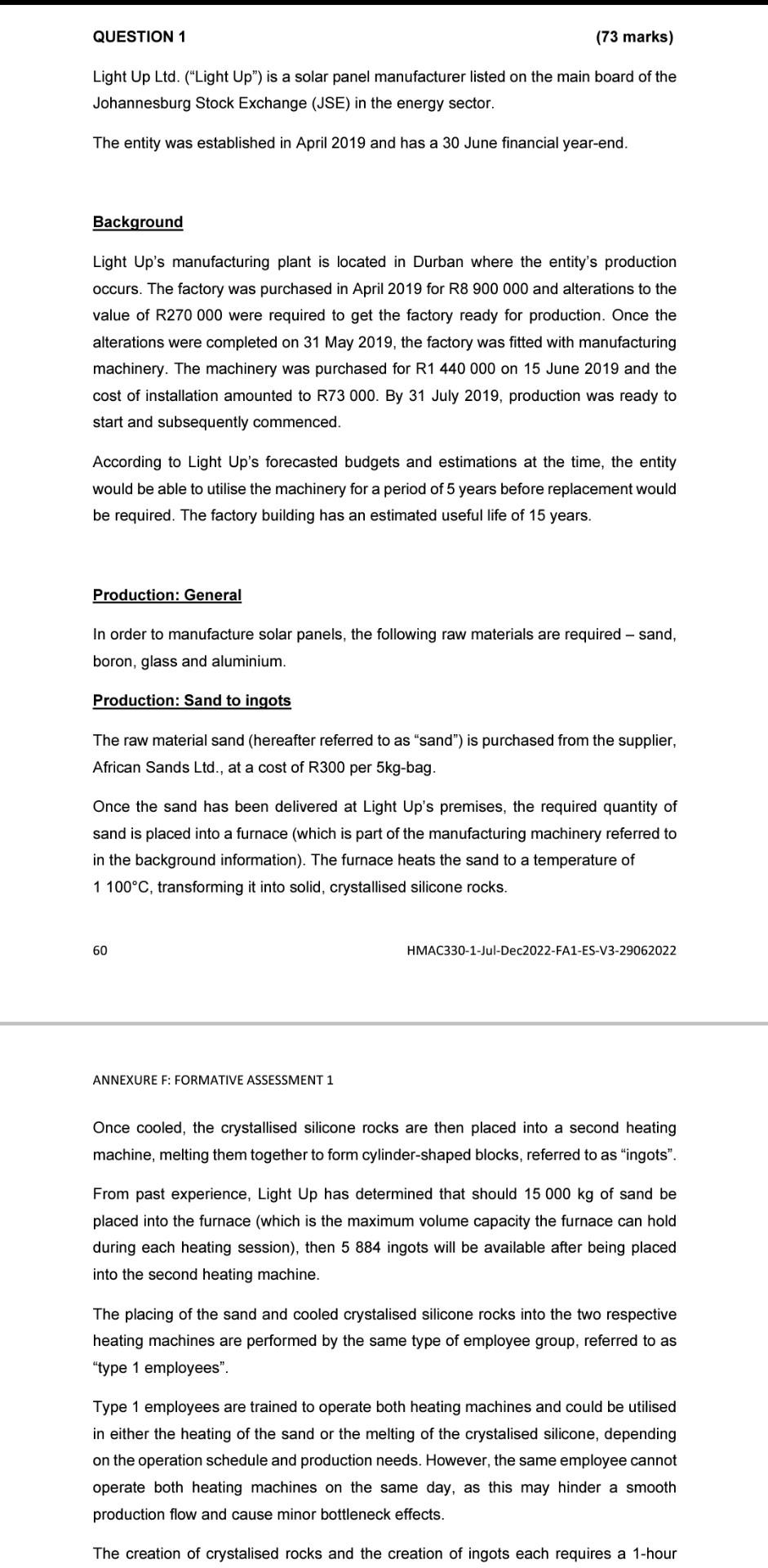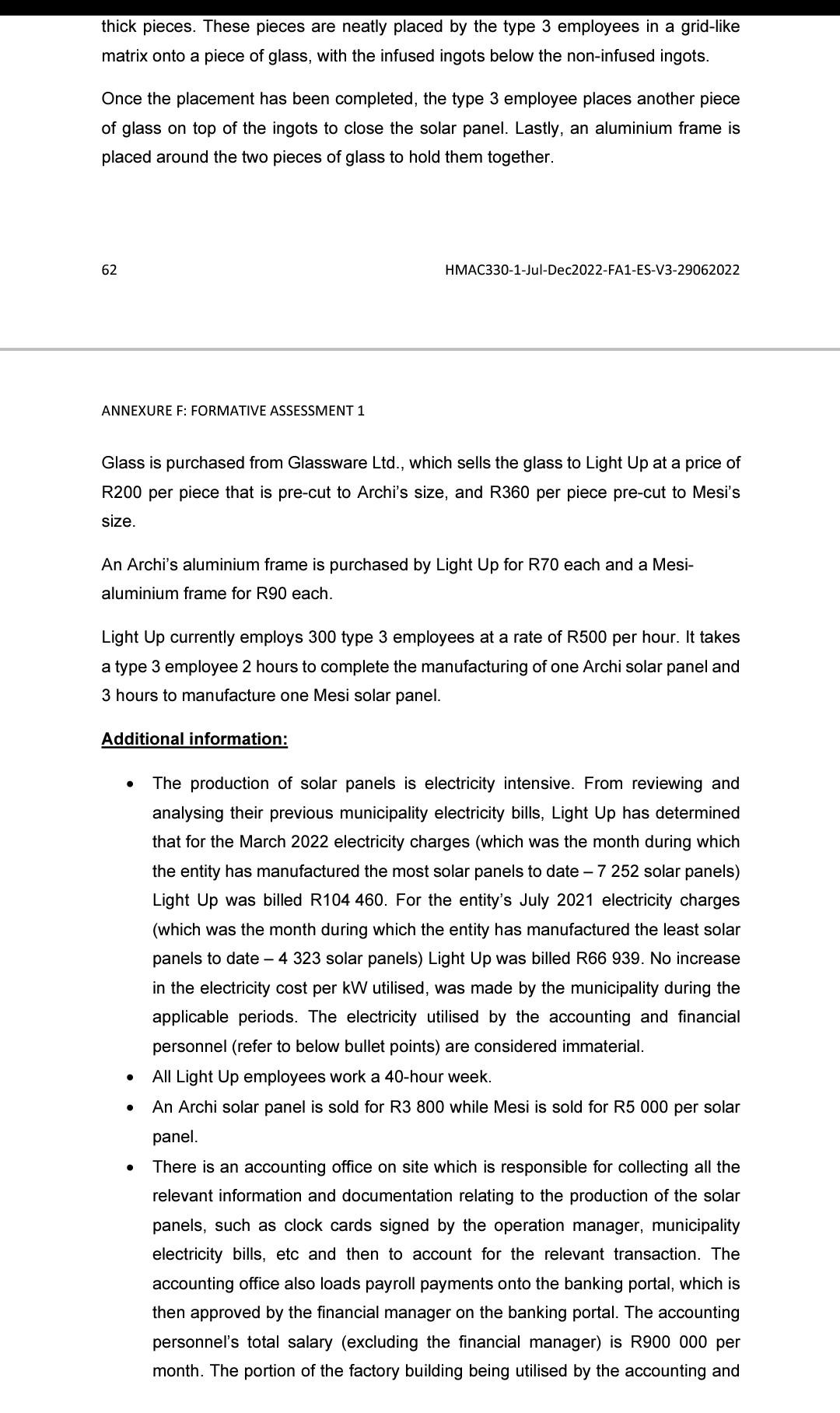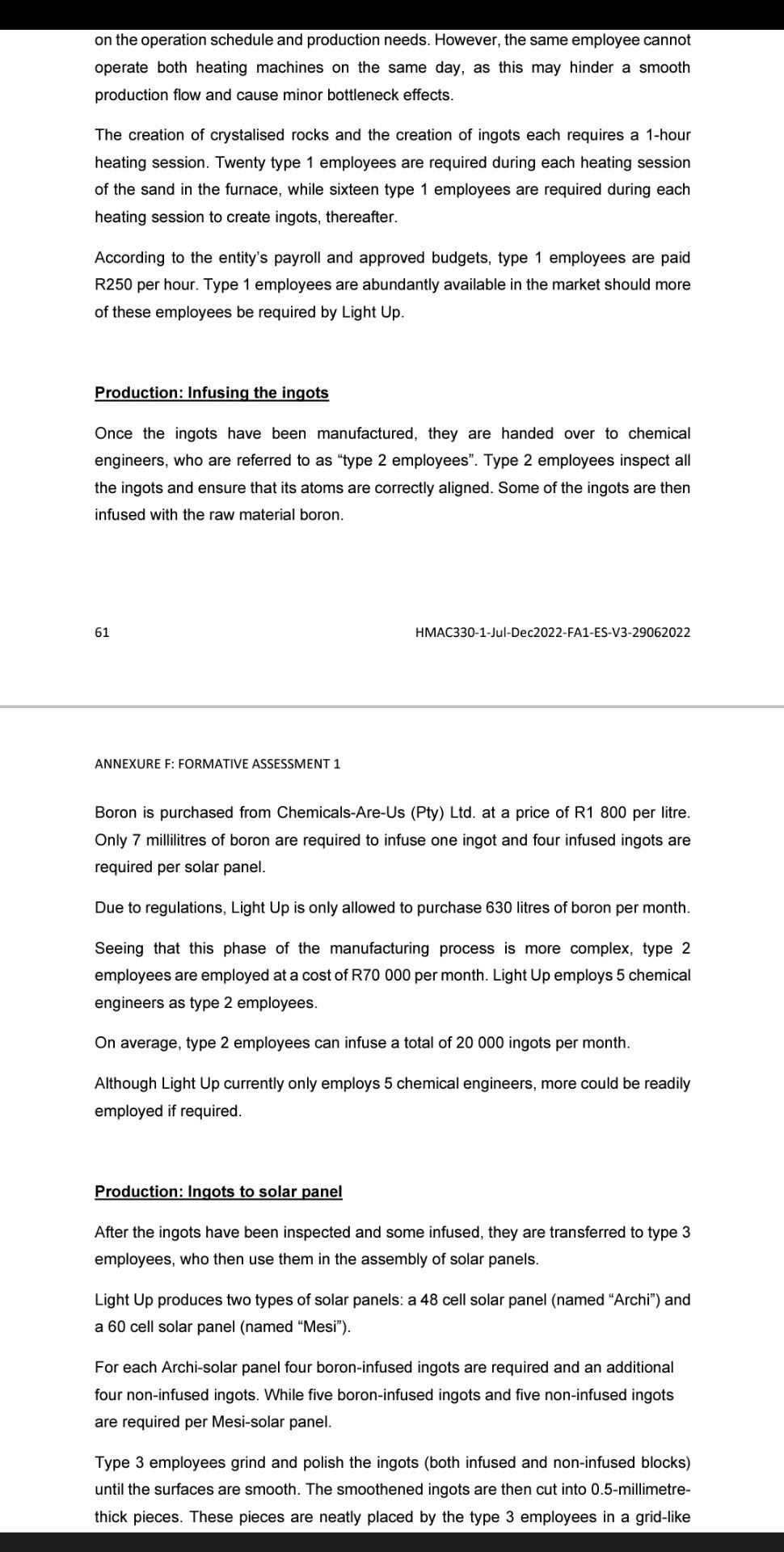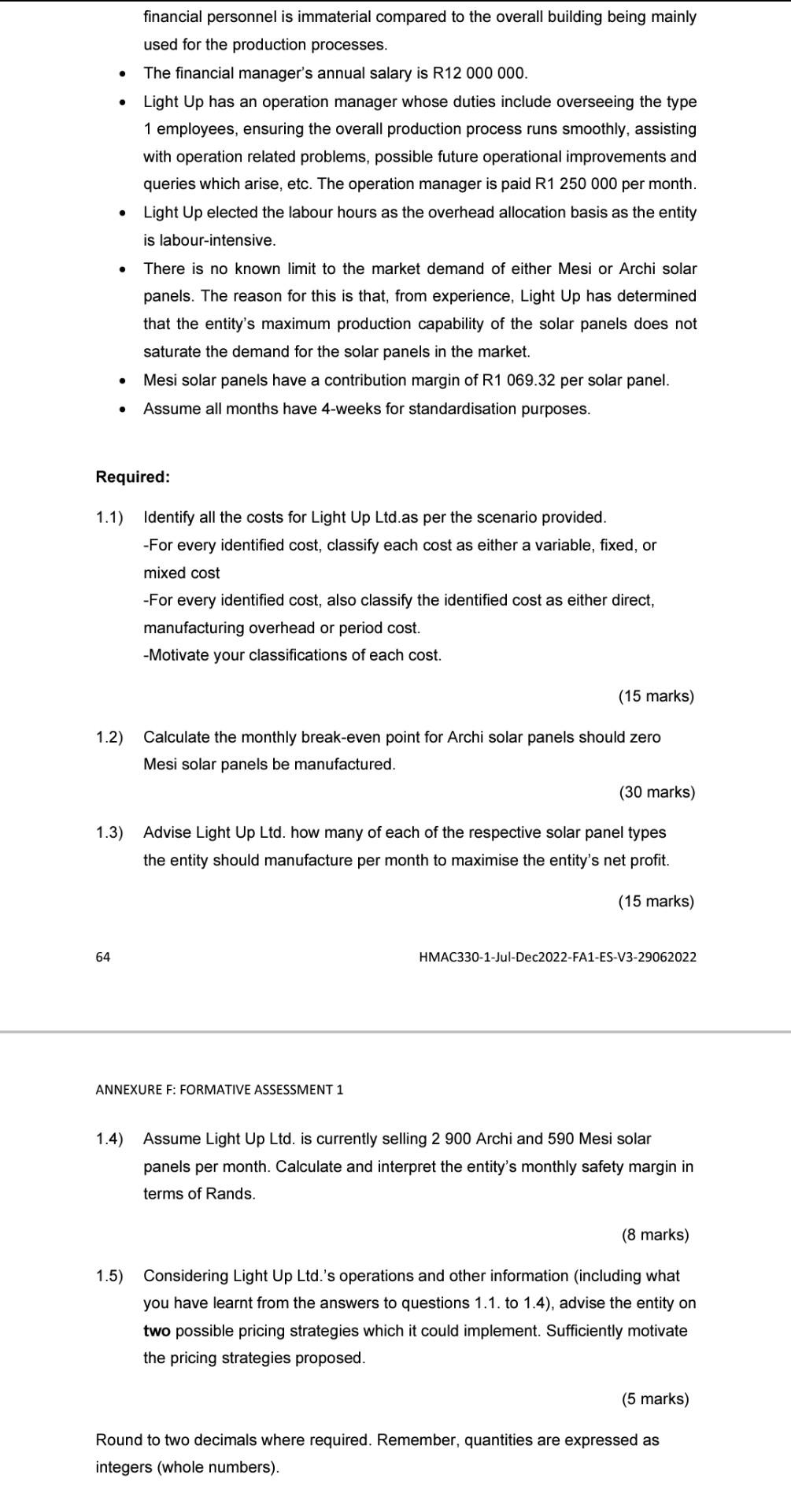Answered step by step
Verified Expert Solution
Question
1 Approved Answer
please help QUESTION 1 (73 marks) Light Up Ltd. (Light Up) is a solar panel manufacturer listed on the main board of the Johannesburg Stock




please help
QUESTION 1 (73 marks) Light Up Ltd. ("Light Up") is a solar panel manufacturer listed on the main board of the Johannesburg Stock Exchange (JSE) in the energy sector. The entity was established in April 2019 and has a 30 June financial year-end. Background Light Up's manufacturing plant is located in Durban where the entity's production occurs. The factory was purchased in April 2019 for R8 900000 and alterations to the value of R270000 were required to get the factory ready for production. Once the alterations were completed on 31 May 2019, the factory was fitted with manufacturing machinery. The machinery was purchased for R1440 000 on 15 June 2019 and the cost of installation amounted to R73 000. By 31 July 2019, production was ready to start and subsequently commenced. According to Light Up's forecasted budgets and estimations at the time, the entity would be able to utilise the machinery for a period of 5 years before replacement would be required. The factory building has an estimated useful life of 15 years. Production: General In order to manufacture solar panels, the following raw materials are required - sand, boron, glass and aluminium. Production: Sand to ingots The raw material sand (hereafter referred to as "sand") is purchased from the supplier, African Sands Ltd., at a cost of R300 per 5kg-bag. Once the sand has been delivered at Light Up's premises, the required quantity of sand is placed into a furnace (which is part of the manufacturing machinery referred to in the background information). The furnace heats the sand to a temperature of 1100C, transforming it into solid, crystallised silicone rocks. 60 HMAC330-1-Jul-Dec2022-FA1-ES-V3-29062022 ANNEXURE F: FORMATIVE ASSESSMENT 1 Once cooled, the crystallised silicone rocks are then placed into a second heating machine, melting them together to form cylinder-shaped blocks, referred to as "ingots". From past experience, Light Up has determined that should 15000kg of sand be placed into the furnace (which is the maximum volume capacity the furnace can hold during each heating session), then 5884 ingots will be available after being placed into the second heating machine. The placing of the sand and cooled crystalised silicone rocks into the two respective heating machines are performed by the same type of employee group, referred to as "type 1 employees". Type 1 employees are trained to operate both heating machines and could be utilised in either the heating of the sand or the melting of the crystalised silicone, depending on the operation schedule and production needs. However, the same employee cannot operate both heating machines on the same day, as this may hinder a smooth production flow and cause minor bottleneck effects. The creation of crystalised rocks and the creation of ingots each requires a 1-hour thick pieces. These pieces are neatly placed by the type 3 employees in a grid-like matrix onto a piece of glass, with the infused ingots below the non-infused ingots. Once the placement has been completed, the type 3 employee places another piece of glass on top of the ingots to close the solar panel. Lastly, an aluminium frame is placed around the two pieces of glass to hold them together. 62 HMAC330-1-Jul-Dec2022-FA1-ES-V3-29062022 ANNEXURE F: FORMATIVE ASSESSMENT 1 Glass is purchased from Glassware Ltd., which sells the glass to Light Up at a price of R200 per piece that is pre-cut to Archi's size, and R360 per piece pre-cut to Mesi's size. An Archi's aluminium frame is purchased by Light Up for R70 each and a Mesialuminium frame for R90 each. Light Up currently employs 300 type 3 employees at a rate of R500 per hour. It takes a type 3 employee 2 hours to complete the manufacturing of one Archi solar panel and 3 hours to manufacture one Mesi solar panel. Additional information: - The production of solar panels is electricity intensive. From reviewing and analysing their previous municipality electricity bills, Light Up has determined that for the March 2022 electricity charges (which was the month during which the entity has manufactured the most solar panels to date 7252 solar panels) Light Up was billed R104 460. For the entity's July 2021 electricity charges (which was the month during which the entity has manufactured the least solar panels to date - 4323 solar panels) Light Up was billed R66 939 . No increase in the electricity cost per kW utilised, was made by the municipality during the applicable periods. The electricity utilised by the accounting and financial personnel (refer to below bullet points) are considered immaterial. - All Light Up employees work a 40-hour week. - An Archi solar panel is sold for R3 800 while Mesi is sold for R5 000 per solar panel. - There is an accounting office on site which is responsible for collecting all the relevant information and documentation relating to the production of the solar panels, such as clock cards signed by the operation manager, municipality electricity bills, etc and then to account for the relevant transaction. The accounting office also loads payroll payments onto the banking portal, which is then approved by the financial manager on the banking portal. The accounting personnel's total salary (excluding the financial manager) is R900000 per month. The portion of the factory building being utilised by the accounting and on the operation schedule and production needs. However, the same employee cannot operate both heating machines on the same day, as this may hinder a smooth production flow and cause minor bottleneck effects. The creation of crystalised rocks and the creation of ingots each requires a 1-hour heating session. Twenty type 1 employees are required during each heating session of the sand in the furnace, while sixteen type 1 employees are required during each heating session to create ingots, thereafter. According to the entity's payroll and approved budgets, type 1 employees are paid R250 per hour. Type 1 employees are abundantly available in the market should more of these employees be required by Light Up. Production: Infusing the ingots Once the ingots have been manufactured, they are handed over to chemical engineers, who are referred to as "type 2 employees". Type 2 employees inspect all the ingots and ensure that its atoms are correctly aligned. Some of the ingots are then infused with the raw material boron. 61 HMAC330-1-Jul-Dec2022-FA1-ES-V3-29062022 ANNEXURE F: FORMATIVE ASSESSMENT 1 Boron is purchased from Chemicals-Are-Us (Pty) Ltd. at a price of R1 800 per litre. Only 7 millilitres of boron are required to infuse one ingot and four infused ingots are required per solar panel. Due to regulations, Light Up is only allowed to purchase 630 litres of boron per month. Seeing that this phase of the manufacturing process is more complex, type 2 employees are employed at a cost of R70 000 per month. Light Up employs 5 chemical engineers as type 2 employees. On average, type 2 employees can infuse a total of 20000 ingots per month. Although Light Up currently only employs 5 chemical engineers, more could be readily employed if required. Production: Ingots to solar panel After the ingots have been inspected and some infused, they are transferred to type 3 employees, who then use them in the assembly of solar panels. Light Up produces two types of solar panels: a 48 cell solar panel (named "Archi") and a 60 cell solar panel (named "Mesi"). For each Archi-solar panel four boron-infused ingots are required and an additional four non-infused ingots. While five boron-infused ingots and five non-infused ingots are required per Mesi-solar panel. Type 3 employees grind and polish the ingots (both infused and non-infused blocks) until the surfaces are smooth. The smoothened ingots are then cut into 0.5-millimetrethick pieces. These pieces are neatly placed by the type 3 employees in a grid-like financial personnel is immaterial compared to the overall building being mainly used for the production processes. - The financial manager's annual salary is R12 000000. - Light Up has an operation manager whose duties include overseeing the type 1 employees, ensuring the overall production process runs smoothly, assisting with operation related problems, possible future operational improvements and queries which arise, etc. The operation manager is paid R1 250000 per month. - Light Up elected the labour hours as the overhead allocation basis as the entity is labour-intensive. - There is no known limit to the market demand of either Mesi or Archi solar panels. The reason for this is that, from experience, Light Up has determined that the entity's maximum production capability of the solar panels does not saturate the demand for the solar panels in the market. - Mesi solar panels have a contribution margin of R1 069.32 per solar panel. - Assume all months have 4-weeks for standardisation purposes. Required: 1.1) Identify all the costs for Light Up Ltd.as per the scenario provided. -For every identified cost, classify each cost as either a variable, fixed, or mixed cost -For every identified cost, also classify the identified cost as either direct, manufacturing overhead or period cost. -Motivate your classifications of each cost. 1.2) Calculate the monthly break-even point for Archi solar panels should zero Mesi solar panels be manufactured. (15 marks) 1.3) Advise Light Up Ltd. how many of each of the respective solar panel types the entity should manufacture per month to maximise the entity's net profit. (15 marks) 64 HMAC330-1-Jul-Dec2022-FA1-ES-V3-29062022 ANNEXURE F: FORMATIVE ASSESSMENT 1 1.4) Assume Light Up Ltd. is currently selling 2900 Archi and 590 Mesi solar panels per month. Calculate and interpret the entity's monthly safety margin in terms of Rands. (8 marks) 1.5) Considering Light Up Ltd.'s operations and other information (including what you have learnt from the answers to questions 1.1. to 1.4), advise the entity on two possible pricing strategies which it could implement. Sufficiently motivate the pricing strategies proposed. (5 marks) Round to two decimals where required. Remember, quantities are expressed as integers (whole numbers). QUESTION 1 (73 marks) Light Up Ltd. ("Light Up") is a solar panel manufacturer listed on the main board of the Johannesburg Stock Exchange (JSE) in the energy sector. The entity was established in April 2019 and has a 30 June financial year-end. Background Light Up's manufacturing plant is located in Durban where the entity's production occurs. The factory was purchased in April 2019 for R8 900000 and alterations to the value of R270000 were required to get the factory ready for production. Once the alterations were completed on 31 May 2019, the factory was fitted with manufacturing machinery. The machinery was purchased for R1440 000 on 15 June 2019 and the cost of installation amounted to R73 000. By 31 July 2019, production was ready to start and subsequently commenced. According to Light Up's forecasted budgets and estimations at the time, the entity would be able to utilise the machinery for a period of 5 years before replacement would be required. The factory building has an estimated useful life of 15 years. Production: General In order to manufacture solar panels, the following raw materials are required - sand, boron, glass and aluminium. Production: Sand to ingots The raw material sand (hereafter referred to as "sand") is purchased from the supplier, African Sands Ltd., at a cost of R300 per 5kg-bag. Once the sand has been delivered at Light Up's premises, the required quantity of sand is placed into a furnace (which is part of the manufacturing machinery referred to in the background information). The furnace heats the sand to a temperature of 1100C, transforming it into solid, crystallised silicone rocks. 60 HMAC330-1-Jul-Dec2022-FA1-ES-V3-29062022 ANNEXURE F: FORMATIVE ASSESSMENT 1 Once cooled, the crystallised silicone rocks are then placed into a second heating machine, melting them together to form cylinder-shaped blocks, referred to as "ingots". From past experience, Light Up has determined that should 15000kg of sand be placed into the furnace (which is the maximum volume capacity the furnace can hold during each heating session), then 5884 ingots will be available after being placed into the second heating machine. The placing of the sand and cooled crystalised silicone rocks into the two respective heating machines are performed by the same type of employee group, referred to as "type 1 employees". Type 1 employees are trained to operate both heating machines and could be utilised in either the heating of the sand or the melting of the crystalised silicone, depending on the operation schedule and production needs. However, the same employee cannot operate both heating machines on the same day, as this may hinder a smooth production flow and cause minor bottleneck effects. The creation of crystalised rocks and the creation of ingots each requires a 1-hour thick pieces. These pieces are neatly placed by the type 3 employees in a grid-like matrix onto a piece of glass, with the infused ingots below the non-infused ingots. Once the placement has been completed, the type 3 employee places another piece of glass on top of the ingots to close the solar panel. Lastly, an aluminium frame is placed around the two pieces of glass to hold them together. 62 HMAC330-1-Jul-Dec2022-FA1-ES-V3-29062022 ANNEXURE F: FORMATIVE ASSESSMENT 1 Glass is purchased from Glassware Ltd., which sells the glass to Light Up at a price of R200 per piece that is pre-cut to Archi's size, and R360 per piece pre-cut to Mesi's size. An Archi's aluminium frame is purchased by Light Up for R70 each and a Mesialuminium frame for R90 each. Light Up currently employs 300 type 3 employees at a rate of R500 per hour. It takes a type 3 employee 2 hours to complete the manufacturing of one Archi solar panel and 3 hours to manufacture one Mesi solar panel. Additional information: - The production of solar panels is electricity intensive. From reviewing and analysing their previous municipality electricity bills, Light Up has determined that for the March 2022 electricity charges (which was the month during which the entity has manufactured the most solar panels to date 7252 solar panels) Light Up was billed R104 460. For the entity's July 2021 electricity charges (which was the month during which the entity has manufactured the least solar panels to date - 4323 solar panels) Light Up was billed R66 939 . No increase in the electricity cost per kW utilised, was made by the municipality during the applicable periods. The electricity utilised by the accounting and financial personnel (refer to below bullet points) are considered immaterial. - All Light Up employees work a 40-hour week. - An Archi solar panel is sold for R3 800 while Mesi is sold for R5 000 per solar panel. - There is an accounting office on site which is responsible for collecting all the relevant information and documentation relating to the production of the solar panels, such as clock cards signed by the operation manager, municipality electricity bills, etc and then to account for the relevant transaction. The accounting office also loads payroll payments onto the banking portal, which is then approved by the financial manager on the banking portal. The accounting personnel's total salary (excluding the financial manager) is R900000 per month. The portion of the factory building being utilised by the accounting and on the operation schedule and production needs. However, the same employee cannot operate both heating machines on the same day, as this may hinder a smooth production flow and cause minor bottleneck effects. The creation of crystalised rocks and the creation of ingots each requires a 1-hour heating session. Twenty type 1 employees are required during each heating session of the sand in the furnace, while sixteen type 1 employees are required during each heating session to create ingots, thereafter. According to the entity's payroll and approved budgets, type 1 employees are paid R250 per hour. Type 1 employees are abundantly available in the market should more of these employees be required by Light Up. Production: Infusing the ingots Once the ingots have been manufactured, they are handed over to chemical engineers, who are referred to as "type 2 employees". Type 2 employees inspect all the ingots and ensure that its atoms are correctly aligned. Some of the ingots are then infused with the raw material boron. 61 HMAC330-1-Jul-Dec2022-FA1-ES-V3-29062022 ANNEXURE F: FORMATIVE ASSESSMENT 1 Boron is purchased from Chemicals-Are-Us (Pty) Ltd. at a price of R1 800 per litre. Only 7 millilitres of boron are required to infuse one ingot and four infused ingots are required per solar panel. Due to regulations, Light Up is only allowed to purchase 630 litres of boron per month. Seeing that this phase of the manufacturing process is more complex, type 2 employees are employed at a cost of R70 000 per month. Light Up employs 5 chemical engineers as type 2 employees. On average, type 2 employees can infuse a total of 20000 ingots per month. Although Light Up currently only employs 5 chemical engineers, more could be readily employed if required. Production: Ingots to solar panel After the ingots have been inspected and some infused, they are transferred to type 3 employees, who then use them in the assembly of solar panels. Light Up produces two types of solar panels: a 48 cell solar panel (named "Archi") and a 60 cell solar panel (named "Mesi"). For each Archi-solar panel four boron-infused ingots are required and an additional four non-infused ingots. While five boron-infused ingots and five non-infused ingots are required per Mesi-solar panel. Type 3 employees grind and polish the ingots (both infused and non-infused blocks) until the surfaces are smooth. The smoothened ingots are then cut into 0.5-millimetrethick pieces. These pieces are neatly placed by the type 3 employees in a grid-like financial personnel is immaterial compared to the overall building being mainly used for the production processes. - The financial manager's annual salary is R12 000000. - Light Up has an operation manager whose duties include overseeing the type 1 employees, ensuring the overall production process runs smoothly, assisting with operation related problems, possible future operational improvements and queries which arise, etc. The operation manager is paid R1 250000 per month. - Light Up elected the labour hours as the overhead allocation basis as the entity is labour-intensive. - There is no known limit to the market demand of either Mesi or Archi solar panels. The reason for this is that, from experience, Light Up has determined that the entity's maximum production capability of the solar panels does not saturate the demand for the solar panels in the market. - Mesi solar panels have a contribution margin of R1 069.32 per solar panel. - Assume all months have 4-weeks for standardisation purposes. Required: 1.1) Identify all the costs for Light Up Ltd.as per the scenario provided. -For every identified cost, classify each cost as either a variable, fixed, or mixed cost -For every identified cost, also classify the identified cost as either direct, manufacturing overhead or period cost. -Motivate your classifications of each cost. 1.2) Calculate the monthly break-even point for Archi solar panels should zero Mesi solar panels be manufactured. (15 marks) 1.3) Advise Light Up Ltd. how many of each of the respective solar panel types the entity should manufacture per month to maximise the entity's net profit. (15 marks) 64 HMAC330-1-Jul-Dec2022-FA1-ES-V3-29062022 ANNEXURE F: FORMATIVE ASSESSMENT 1 1.4) Assume Light Up Ltd. is currently selling 2900 Archi and 590 Mesi solar panels per month. Calculate and interpret the entity's monthly safety margin in terms of Rands. (8 marks) 1.5) Considering Light Up Ltd.'s operations and other information (including what you have learnt from the answers to questions 1.1. to 1.4), advise the entity on two possible pricing strategies which it could implement. Sufficiently motivate the pricing strategies proposed. (5 marks) Round to two decimals where required. Remember, quantities are expressed as integers (whole numbers)Step by Step Solution
There are 3 Steps involved in it
Step: 1

Get Instant Access to Expert-Tailored Solutions
See step-by-step solutions with expert insights and AI powered tools for academic success
Step: 2

Step: 3

Ace Your Homework with AI
Get the answers you need in no time with our AI-driven, step-by-step assistance
Get Started


